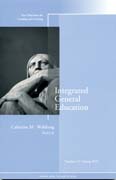
General education has been an essential part of American higher education fora long time. Unfortunately, it is often seen as something to "get out of the way" so that the student can go on to take the more "important" courses withina chosen major. This volume changes that perception. Topics discussed include: OL {list-style:disc} P:{margin-left 60px} * Integrated General Education: A Brief Look Back * Why are Outcomes So Difficult to Achieve? * Making General Education Matter: Structures and Strategies * Unifying the Undergraduate Curriculum Through Inquiry-Guided Learning * University of the Pacific's Bookend Seminars on a Good Society * Core Curriculum Revision at TCU: How Faculty Createdand Are Maintaining the TCU Core Curriculum * Creating an Integrative GeneralEducation: The Bates Experience * Building an Integrated Student Learning Outcomes Assessment for General Education: Three Case Studies * Meaningful General Education Assessment That is Integrated and Transformative Institutions of higher education have a responsibility to develop a meaningful general education curriculum that cultivates qualities of thinking, communication, and problemsolving (to name a few of the general education goals that many institutions share). What is missing from many institutions, though, is the concept of integrating general education with the overall educational curriculum. If this is done, general education courses are no longer something to take quickly so they can be checked off; instead; they become part of the educational developmentof the student. This integration benefits the student, certainly, but also the larger society--baccalaureate graduates steeped in the liberal arts will become future leaders. Having been prepared with a broad knowledge base, our current students will be able to think more critically and make good use of information to solve problems that have not yet even been identified. This is the 121st volume of the Jossey-Bass higher education quarterly report series New Directions for Teaching and Learning, which offers a comprehensive range of ideasand techniques for improving college teaching based on the experience of seasoned instructors and the latest findings of educational and psychological researchers INDICE: "PREFACE (Catherine M. Wehlburg). 1. Integrated General Education:A Brief Look Back (Catherine M. Wehlburg) This chapter is an overview of historical trends that have taken general education from the concept of a unified curriculum with no distinction between ""specialized"" and ""general"" education to the current distribution requirement that many institutions use. 2. Since We Seem to Agree, Why Are the Outcomes So Difficult to Achieve? (Terry Rhodes) The Valid Assessment of Learning in Undergraduate Education (VALUE) projectis described and results are presented, along with assessment of outcomes positioned in a national and international context. 3. Making General Education Matter: Structures and Strategies (Joan Hawthorne, Anne Kelsch, Tom Steen) Thischapter focuses on the process used by the University of North Dakota to engage faculty in general education reform by making the program matter to facultyacross disciplines. Their process resulted in a new program that is engaging much of the campus community in creation of a vertically integrated general education program. 4. Unifying the Undergraduate Curriculum Through Inquiry-Guided Learning (Virginia S. Lee, Sarah Ash) This chapter discusses development ofa framework for integrating undergraduate curriculum across general educationand the major. Participating faculty and staff members agreed on four overarching intended learning outcomes as the distinctive feature of inquiry-guided learning: critical thinking, habits of independent inquiry, taking responsibility for one's own learning, and intellectual growth and maturity. 5. Universityof the Pacifics Bookend Seminars on a Good Society (Lou Matz) The signature component of the University of the Pacific's general education program is threerequired Pacific Seminars (PACS) that focus on the question, ""What is a GoodSociety?"" 6. Core Curriculum Revision at TCU: How Faculty Created and Are Maintaining the TCU Core Curriculum (Edward McNertney, Blaise Ferrandino) This chapter describes the faculty-led, participatory process of creating an outcomes-based core curriculum at Texas Christian University. 7. Creating an Integrative General Education: The Bates Experience (Jill Reich, Judy Head) The Bates College general education curriculum is used in this chapter to articulate theimportance of several integrative goals and processes that make up our new General Education curriculum. 8. Building an Integrated Student Learning Outcomes Assessment for General Education: Three Case Studies (Jo K. Galle, Jeffery Galle) Looking across three institutions, the authors found that a three-stage process for developing an integrated general education assessment plan allowedfor institutional differences. What emerged from their work demonstrates the remarkable ways in which institutions of various kinds adapted the stages to fit their own unique academic culture and necessities. 9. Meaningful General Education Assessment That Is Integrated and Transformative (Catherine M. Wehlburg) This chapter describes a transformative approach to assessing general education programs, identifies potential obstacles to successful assessment, and outlines necessary steps for creating assessable outcomesbased programs. INDEX. "
- ISBN: 978-0-470-62634-4
- Editorial: John Wiley & Sons
- Encuadernacion: Rústica
- Páginas: 120
- Fecha Publicación: 16/07/2010
- Nº Volúmenes: 1
- Idioma: Inglés
